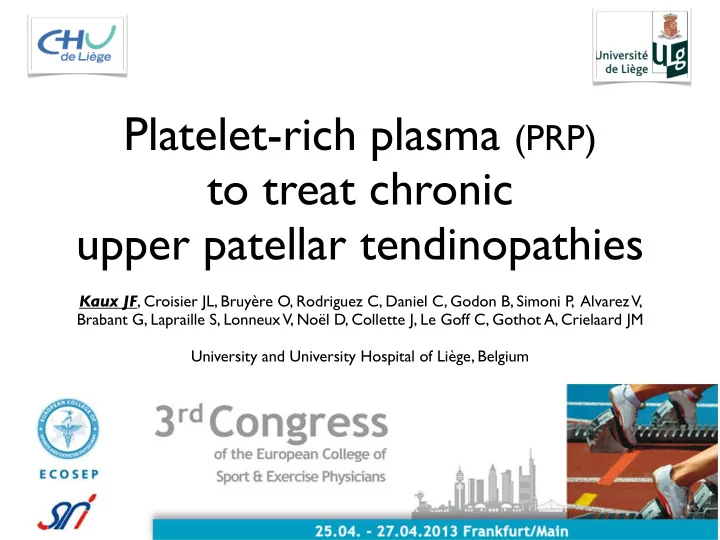

Platelet-rich plasma (PRP) to treat chronic upper patellar tendinopathies Kaux JF , Croisier JL, Bruyère O, Rodriguez C, Daniel C, Godon B, Simoni P , Alvarez V, Brabant G, Lapraille S, Lonneux V, Noël D, Collette J, Le Goff C, Gothot A, Crielaard JM University and University Hospital of Liège, Belgium
Introduction • Upper patellar tendinopathies remain often chronic and resistant to conservative treatment. • New treatments are being developed. • Platelets contain lots of growth factors.
PRP • In vitro and animal experiments have demonstrated that PRP can stimulate the tendon healing process. • Clinical series are subject to controversy.
Methods • 20 patients • Assessments: • VAS • algometer • algofunctional scores (IKDC and VISA-P) • functional assessments (isokinetic and optojump) • imagery (US and MRI) • Evaluations before infiltration, and 6 weeks and 3 months post-infiltration
Methods • PRP obtained by apheresis system (COM.TEC, Fresenius) . • Site located by US. • 6mL of PRP were injected without anaesthetic. • 1 week after infiltration ➙ 6-week standardised sub-maximal eccentric reeducation. • NSAIDs were avoided.
Results VAS p<0.001
Results Algometer p<0.001
Results IKDC - VISA-P p=0.03
Results Isokinetic and optojump US and MRI • Pain felt decreased at each functional evaluation. • No functional improvement. • No improvement in the imagery.
Results • Patients with best improvement ➙ younger (24.7 vs 32.2 y.o.) • VAS ≤ 1 • significant increase of IKDC score (p=0.003) • significant improvement of pain during isokinetic evaluation (p<0.05) and optojump (p=0.01) • 70% return to sport (50% same level) .
Discussion • A local infiltration of PRP + submaximal eccentric reeducation ➙ improvement of symptoms of chronic upper patellar tendinopathies. • No functional or imagery improvement observed.
Discussion • No general agreement on the preparation and use of PRP . • Apheresis system provides: • «pure» PRP (without red and white cells) • reproducible PRP from one patient to another (duration of platelet collect depended on anthropometric and biologic parameters of each patient) • choice of PRP concentration
Conclusion • PRP can be a treatment for resistant chronic tendinopathies. • RCT are still needed.
Thank you for your attention ! jfkaux@chu.ulg.ac.be
Recommend
More recommend